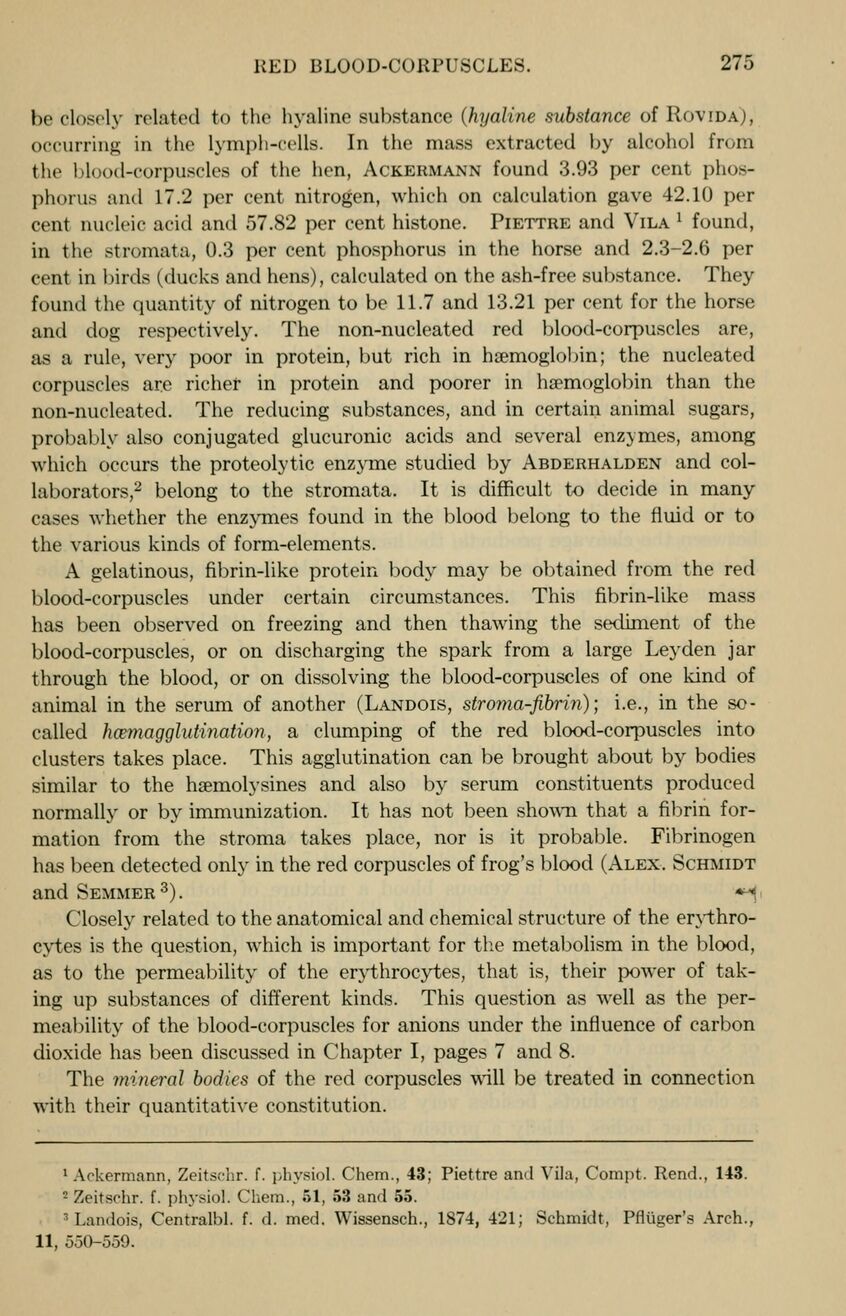
Full resolution (JPEG) - On this page / på denna sida - V. The Blood - II. The Form-elements of the Blood - The Red Blood-corpuscles

<< prev. page << föreg. sida << >> nästa sida >> next page >>
Below is the raw OCR text
from the above scanned image.
Do you see an error? Proofread the page now!
Här nedan syns maskintolkade texten från faksimilbilden ovan.
Ser du något fel? Korrekturläs sidan nu!
This page has never been proofread. / Denna sida har aldrig korrekturlästs.
RED BLOOD-CORPUSCLES. 275
be closely related to the hyaline substance (hyaline substance of Rovida),
occurring in the lymph-cells. In the mass extracted by alcohol from
the blood-corpuscles of the hen, Ackermann found 3.93 per cent phos-
phorus and 17.2 per cent nitrogen, which on calculation gave 42.10 per
cent nucleic acid and 57.82 per cent histone. Piettre and Vila * found,
in the stromata, 0.3 per cent phosphorus in the horse and 2.3-2.6 per
cent in birds (ducks and hens), calculated on the ash-free substance. They
found the quantity of nitrogen to be 11.7 and 13.21 per cent for the horse
and dog respectively. The non-nucleated red blood-corpuscles are,
as a rule, very poor in protein, but rich in haemoglobin; the nucleated
corpuscles are richer in protein and poorer in haemoglobin than the
non-nucleated. The reducing substances, and in certain animal sugars,
probably also conjugated glucuronic acids and several enzymes, among
which occurs the proteolytic enzyme studied by Abderhalden and col-
laborators,2
belong to the stromata. It is difficult to decide in many
cases whether the enzymes found in the blood belong to the fluid or to
the various kinds of form-elements.
A gelatinous, fibrin-like protein body may be obtained from the red
blood-corpuscles under certain circumstances. This fibrin-like mass
has been observed on freezing and then thawing the sediment of the
blood-corpuscles, or on discharging the spark from a large Leyden jar
through the blood, or on dissolving the blood-corpuscles of one kind of
animal in the serum of another (Landois, stroma-fibrin) ;
i.e., in the so-
called hemagglutination, a clumping of the red blood-corpuscles into
clusters takes place. This agglutination can be brought about by bodies
similar to the haemolysines and also by serum constituents produced
normally or by immunization. It has not been shown that a fibrin for-
mation from the stroma takes place, nor is it probable. Fibrinogen
has been detected only in the red corpuscles of frog’s blood (Alex. Schmidt
and Semmer 3
).
*•«
Closely related to the anatomical and chemical structure of the erythro-
cytes is the question, which is important for the metabolism in the blood,
as to the permeability of the erythrocytes, that is, their power of tak-
ing up substances of different kinds. This question as well as the per-
meability of the blood-corpuscles for anions under the influence of carbon
dioxide has been discussed in Chapter I, pages 7 and 8.
The mineral bodies of the red corpuscles will be treated in connection
with their quantitative constitution.
1
Ackermann, Zeitschr. f. physiol. Chem., 43; Piettre and Vila, Compt. Rend., 143.
- Zeitschr. f. physiol. Chem., 51, 53 and 55.
3
Landois, Centralbl. f. d. med. Wissensch., 1874, 421; Schmidt, Pfliiger’s Arch.,
11, 550-559.
<< prev. page << föreg. sida << >> nästa sida >> next page >>